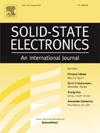Low cost Ni-based electrodeposited pn-junction thermoelectric device for thermoelectric sensor application
IF 1.4
4区 物理与天体物理
Q3 ENGINEERING, ELECTRICAL & ELECTRONIC
引用次数: 0
Abstract
This paper proposes a novel low cost atoxic Ni-based pn-junction thermoelectric device. The device fabrication begins with the growth of Ni-CuI and Ni-ZnO films on ITO by electrodeposition method followed by exploring their structural, morphological and thermoelectric properties. XRD and SEM analysis revealed high crystallinity and uniform nano grains in both layers. Hot probe confirmed the p-type Ni-CuI and n-type Ni-ZnO. These high conductive films exhibited thermoelectric energy that was calculated using the Seebeck effect. The thermoelectric effect showed that an increase in temperature result in an increase in induced electromotive force (emf). From the thermo emf measurements, the induced emf for Ni-CuI film was found to be 2.2 mV/K and 2.2 mV/K for Ni-ZnO film at 300 °C. The Seebeck values of Ni-CuI and Ni-ZnO were calculated to be 83 μVK−1 and −98 μVK−1 respectively. The hot probe method showed that the p-type Ni-CuI and n-type Ni-ZnO thin films were dense and exhibited thermoelectric figure of merit (ZT) of 1.2 and 1.5 up to the temperature of 300 ̊ C. The temperature-dependent power factor of Ni-CuI and Ni-ZnO was found to be 436 µWm-1K−2 and 977 µWm-1K−2 respectively. The fabricated pn-junction device produced the temperature-dependent output voltage 500 mV at 300 °C. The thermoelectric device generated a maximum power of 1250 pW that reveals that the Ni-CuI/Ni-ZnO pn-junction devices are likely suitable for thermoelectric sensor applications.
求助全文
约1分钟内获得全文
求助全文
来源期刊

Solid-state Electronics
物理-工程:电子与电气
CiteScore
3.00
自引率
5.90%
发文量
212
审稿时长
3 months
期刊介绍:
It is the aim of this journal to bring together in one publication outstanding papers reporting new and original work in the following areas: (1) applications of solid-state physics and technology to electronics and optoelectronics, including theory and device design; (2) optical, electrical, morphological characterization techniques and parameter extraction of devices; (3) fabrication of semiconductor devices, and also device-related materials growth, measurement and evaluation; (4) the physics and modeling of submicron and nanoscale microelectronic and optoelectronic devices, including processing, measurement, and performance evaluation; (5) applications of numerical methods to the modeling and simulation of solid-state devices and processes; and (6) nanoscale electronic and optoelectronic devices, photovoltaics, sensors, and MEMS based on semiconductor and alternative electronic materials; (7) synthesis and electrooptical properties of materials for novel devices.
 求助内容:
求助内容: 应助结果提醒方式:
应助结果提醒方式:


